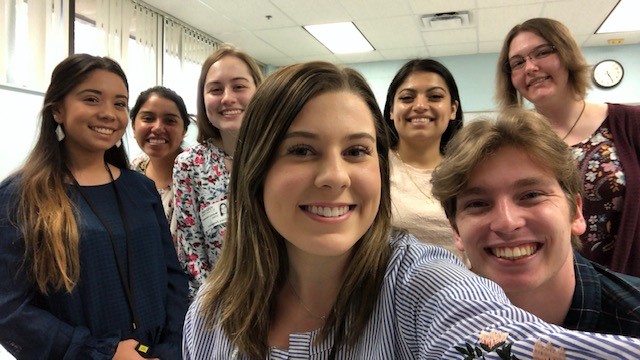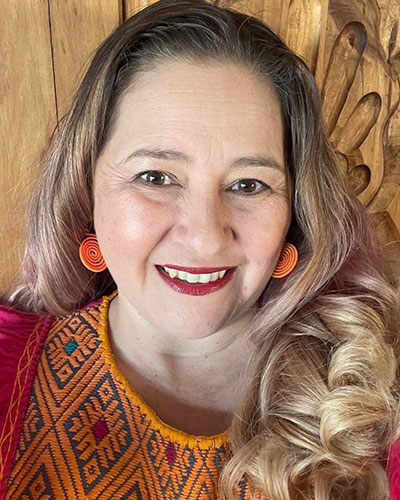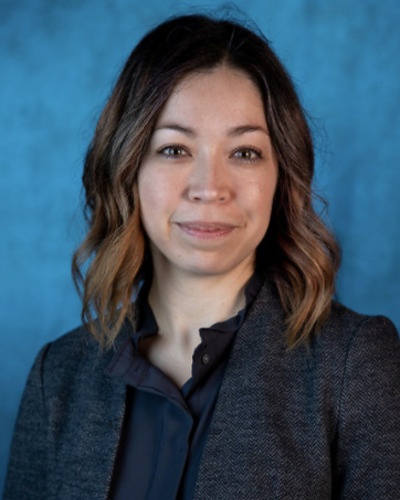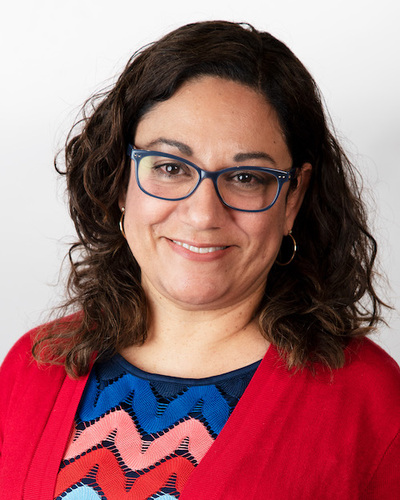UTSA COEHD Signature Teacher Residency Model
Partnering with local school districts for a clinically-rich educator preparation experience
Partnering with local school districts for a clinically-rich educator preparation experience, the UTSA COEHD Signature Teacher Residency Model provides cohorts of teacher candidates with clinically-embedded coursework.
The Signature Teacher Residency Model includes more opportunities to teach, learn, and interact with PK-12 students, teachers, and administrators so that residency graduates are ready to lead their own classrooms and fully participate in the district community from day one. Signature Teacher Residency participants are exemplars of culturally efficacious agents of change that are knowledgeable, professional, and community-based.
In June of 2021, the Texas Education Agency approved UTSA COEHD as a Vetted Teacher Residency Program, stating that UTSA "demonstrated evidence of the necessary criteria of a program that is prepared to scale high quality, sustainable residency models". UTSA's COEHD Signature Teacher Residency model is implemented through partnerships and agreements with various school districts.
The Signature Teacher Residency Model provides the opportunity for our teacher candidates to participate in the educational growth of students over a longer period, while simultaneously integrating coursework into the clinical experience.
Signature Residency Models are quickly becoming the preferred approach for educator preparation programs, as research demonstrates that it is a more effective model for preparing aspiring teachers to become highly qualified educators, who can ensure the success of all students. Click Here for an article that summarizes recent studies regarding research on educator preparation pathways.
Currently, our teacher candidates pursuing certification in EC-6 Core, EC-6 ESL, and EC-6 Bilingual Education all participate in a signature residency model during their clinical year, and plans are underway to expand to all certification areas: middle, secondary, and all-level EC-12.
Core components of the Signature Teacher Residency Model include:
- Clinically-embedded coursework
- Carefully selected Mentor Teachers
- Year-long clinical teaching (two semesters)
- Co-teaching and Co-planning with Mentor Teacher from day one
- Weekly clinical seminars
Teacher candidates may apply to one of the following residency programs: TCLAS (East Central ISD, Edgewood ISD, Harlandale ISD, North East ISD, San Antonio ISD, and Somerset ISD); UTSA-Northside ISD Signature PreClinical through Clinical Teacher Residency, or UTSA-NISD CAST Teach High School Residency.
Please download the Signature Teacher Residency Model brochure.
Texas COVID Learning Acceleration Supports (TCLAS) is temporary funding from the Texas Education Agency available to vet Signature Teacher Residency Programs and their partnering districts. As a TEA-Vetted Residency, UTSA COEHD is partnering with the following local school districts to receive TCLAS funding for clinical teachers: East Central ISD, Edgewood ISD, Harlandale ISD, North East ISD, San Antonio ISD, and Somerset ISD.
Teacher Residents are paired with carefully selected mentor teachers, follow the district teachers' calendar, participate in district-led professional learning sessions, record and critically reflect on their instructional practices, participate in residency seminars led by dedicated residency faculty, and are paid by the district.
Applications must be submitted the semester before the teacher candidate begins their clinical year.
Application process:
- UTSA Educator Preparation Program (EPP) representative(s) will contact eligible teacher candidates to provide resumes for partner districts to review.
- Partner districts schedule and conduct interviews.
- UTSA Educator Preparation Program (EPP) representative(s) will inform candidates of district decisions.
- Candidate reviews and signs letter of acceptance and returns signed agreement form to UTSA
EISD Clinical Teacher Residency video:
The Education Trust and Partners - Administrators - Thomasina Montaña (Captioned)
Contact for TCLAS information:
Dr. Youmna Dbouk
Director of Clinical Professional Experiences
Since 2017, UTSA has been in partnership with the Northside ISD in the co-creation of a district-specific residency program. The UTSA-NISD Signature Teacher Residency program provides cohorts of pre-clinical through clinical teacher candidates with extended opportunities to teach, learn, and interact with K-12 students, teachers, and administrators. Participation in the UTSA-NISD Signature Teacher Residency is a multi-semester/multi-year agreement, though no additional courses are required. Teacher Candidates pursuing certification in all areas (EC-6 Core, ESL, Bilingual, 4-8, Secondary, All-level) are welcome to apply after they have been accepted to the UTSA teacher certification program.
Signature Teacher Residents are paired with carefully selected mentor teachers, participate in district-led professional learning sessions, record and critically reflect on their instructional practices, are eligible for employment opportunities with the district, and develop a strong network of support through interactions in residency seminars led by dedicated residency faculty. During pre-clinical semesters, residents are paired with a mentor teacher for weekly observations and co-teaching experiences. They also participate in monthly seminars with their residency cohort. During the clinical year, residents follow the district teachers' calendar, co-planning and co-teaching with their mentor for 5 days a week when UTSA classes are not in session, and 3 days per week when UTSA classes are in session. Residency graduates are ready to lead their own classroom and fully participate in the NISD community as culturally efficacious educators from day one. They are invited to continue collaboration with their residency cohort, and after at least 3 years as teachers of record, are eligible to be considered as residency mentor teachers.
Applications can be submitted at any time before the clinical year, with candidates preferably joining the residency in their sophomore or first-semester junior year and continuing through their year-long clinical teaching experience at UTSA.
Application process for all UTSA-NISD Residency programs:
- Teacher Candidate completes and submits an application to UTSA
- UTSA residency committee reviews applications and makes referrals to NISD
- NISD conducts interviews and contacts UTSA with recommendations for accepted residents
- UTSA informs candidates of district decisions
Candidate reviews and signs letter of acceptance and returns signed agreement form to UTSA To complete an application for the UTSA-NISD Signature Teacher Residency
Click here!
Contact for UTSA-NISD Residency information:
Dr. Jennifer Swoyer
Assistant Professor of Instruction
UTSA has partnered with the Northside ISD and the CAST Network to co-create a funded residency for secondary teacher candidates. The UTSA-NISD Signature Teacher Residency program at CAST Teach High School provides cohorts of secondary certification candidates with extended opportunities to teach, learn, and interact with high school students, teachers, and administrators. Participation in the UTSA-NISD Signature Teacher Residency at CAST Teach High School requires a one-year commitment.
Teacher Residents are paired with carefully selected mentor teachers, participate in district-led professional learning sessions, record and critically reflect on their instructional practices, are eligible for employment opportunities with the district, and develop a strong network of support through interactions in residency seminars led by dedicated residency faculty. During the clinical year, residents follow the district teachers' calendar, co-planning, and co-teaching with their mentor. Residency graduates are ready to lead their own classroom and fully participate in the NISD community as culturally efficacious educators from day one. They are invited to continue collaboration with their residency cohort, and after at least 3 years as teachers of record, are eligible to be considered as residency mentor teachers.
Applicants have preferably participated in the pre-clinical UTSA-NISD residency program, though any secondary candidate may apply.
Application process for all UTSA-NISD Residency programs:
- Teacher Candidate completes and submits an application to UTSA ( Click here for the UTSA-NISD Signature Teacher Residency Program Application)
- UTSA residency committee reviews applications and makes referrals to NISD
- NISD conducts interviews and contacts UTSA with recommendations for accepted residents
- UTSA informs candidates of district decisions
- Candidate reviews and signs letter of acceptance and returns signed agreement form to UTSA
Contact for UTSA-NISD Residency information:
Dr. Jennifer Swoyer
Assistant Professor of Instruction
Cohort of Teacher Candidates

Residency participants begin forming their professional network within the residency program. Residency teacher candidates are able to learn from and with one another, sharing experiences in and out of the classroom while in the clinical setting and after graduation.
Carefully Selected Mentor Teachers
Being a great mentor teacher takes more than proven effective classroom experience. Residency Mentor Teachers are carefully selected following recommendations from district partners and UTSA guidelines to ensure that they have the interest, skills, and time to commit to the guidance of future educators.
More Interaction with K-12 Students
Teacher candidates work directly with mentor teachers and APiPs to prepare, deliver, record, and reflect on lessons that have been specifically differentiated for the students and aligned with course objectives.
District and Campus Involvement
Residency participants are expected to join in-district professional development opportunities throughout the year - beginning with convocations in August, and continuing with district and campus-led professional learning sessions throughout the year.
Professional learning opportunities familiarize teacher candidates with the culture of the district and allow them to interact with other district educators to begin forming their professional network of support and resources for expertise.
Seminars
All residency participants join together as a Community of Practice for seminars. Seminar topics are guided by the needs and interests of our teacher candidates.
Examples of seminar topics include (but are not limited to) culturally efficacious teaching practices, certification exam preparation, student engagement strategies, creating professional portfolios, and preparing for professional interviews.
Research and Presentation Opportunities
Teacher Candidates participate in critical reflection related to their clinical experiences and program development. This action research is often shared in local conferences and publications. Residency participants also often serve as stewards of the residency model to promote and recruit future Roadrunners.
Residency Program Faculty





